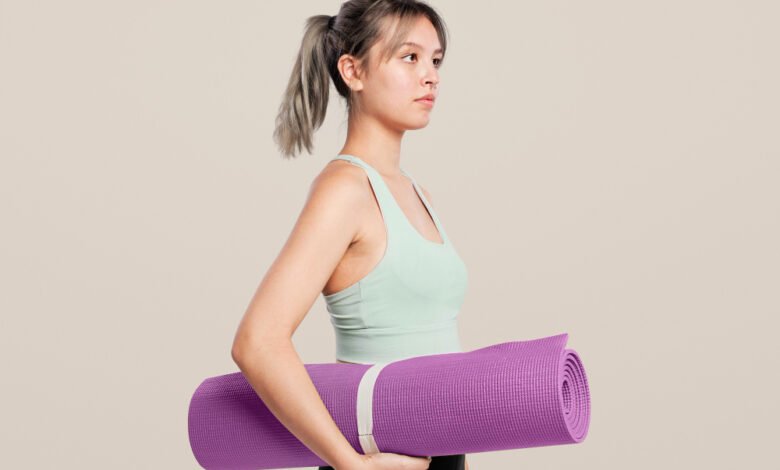A Foundation of Comfort: Exploring the Importance of Yoga Mats in Practice

Yoga is a practice that emphasizes concord among thoughts, frame, and spirit. Central to this practice is the yoga mat, which serves as the muse for all moves, postures, and breathwork.
While it could appear to be a simple accent, the yoga mat plays a vital role in enhancing consolation, stability, and protection throughout exercise. In this text, we delve into the importance of yoga mats because they are the cornerstone of a fulfilling and enriching yoga experience.
Enhancing Comfort and Support
The primary purpose of a yoga mat is to offer a snug and supportive surface for practitioners to perform their asanas (postures) and actions.
The cushioning of the mat protects joints, bones, and sensitive areas of the body from soreness and stress, permitting practitioners to pay attention to their breath and alignment without distraction.
Whether training gentle stretches or difficult inversions, a best yoga mat guarantees a snug and fun experience on the mat.
Creating Stability and Balance
Stability and balance are crucial factors of yoga exercise, and a dependable yoga mat helps facilitate these aspects by offering a corporation and non-slip surface.
The textured grip of the mat prevents arms and toes from slipping for the duration of poses, permitting practitioners to keep proper alignment and balance.
This feel of grounding and balance fosters confidence and empowerment, permitting practitioners to explore their edges and deepen their practice with more ease and safety.
Absorbing Sweat and Moisture
As yoga practice frequently entails bodily exertion and perspiration, a yoga mat serves as a barrier among the practitioner and the floor, soaking up sweat and moisture to keep cleanliness and hygiene.
A moisture-wicking mat prevents slipping and sliding, even in heated or lively yoga training, making sure a secure and hygienic exercise environment.
Additionally, an easy and dry mat contributes to a greater fine and cushty experience, allowing practitioners to fully immerse themselves in their exercise without distraction.
Establishing Personal Space and Boundaries
In a crowded yoga studio or organization class, a yoga mat delineates private space and barriers, providing a sense of privateness and containment amidst a communal practice.
The described area of the mat serves as a sanctuary for self-reflection and introspection, permitting practitioners to turn inward and aware of their personal exercise without interference or distraction from others.
This sense of private space fosters a deeper connection to oneself and complements the meditative factors of the practice.
Reflecting Personal Style and Expression
Beyond its functional blessings, a yoga mat is likewise a mirrored image of personal fashion, character, and expression.
Whether opting for a vibrant print, a calming pastel, or a minimalist layout, the yoga mat will become an extension of the practitioner’s identification and a supply of inspiration and motivation at the mat.
Providing Insulation and Protection
Yoga mats provide insulation from cold or difficult surfaces, providing a barrier between the practitioner and the floor. This insulation helps keep body warmness at some stage in floor-primarily based poses and protects towards pain or injury from difficult or uneven surfaces.
Facilitating Mind-Body Connection
The tactile sensation of the yoga mat below the fingers and feet serves as a factor of attention and connection at some point of practice.
By grounding into the mat, practitioners can cultivate cognizance in their body’s courting to the earth and deepen their thoughts-body connection.
Encouraging Regular Practice and Habit Formation
Having a dedicated yoga mat at home serves as a visible reminder and invitation to practice frequently.
By growing a designated area for yoga exercise, practitioners are much more likely to set up a constant routine and shape advantageous behavior around self-care and nicely-being.
The presence of the yoga mat acts as a catalyst for motivation and area, encouraging practitioners to prioritize their exercise as an critical part of their daily habitual.
Supporting Environmental Consciousness
Many yoga mats are actually made from eco-friendly materials inclusive of natural rubber, cork, or recycled substances, reflecting a dedication to environmental sustainability.
By choosing a sustainable yoga mat, practitioners can align their exercise with their values of environmental cognizance and stewardship.
Fostering Community and Connection
The shared experience of working towards yoga mats creates a sense of network and connection amongst practitioners. Whether in a group elegance or at a yoga retreat, the sight of aligned mats symbolizes unity and shared goal, fostering a feel of belonging and camaraderie.
Conclusion
In the exercise of yoga, the yoga mat serves as greater than just a floor to carry out asanas; it is a foundation of comfort, balance, and self-expression. From improving comfort and assisting to developing balance and stability, the yoga mat performs a vital function in facilitating a fulfilling and enriching yoga revel in.
By spotting the importance of the yoga mat as a cornerstone of practice, practitioners can cultivate a deeper connection to their practice and liberate new dimensions of bodily, intellectual, and spiritual well-being on the mat.



